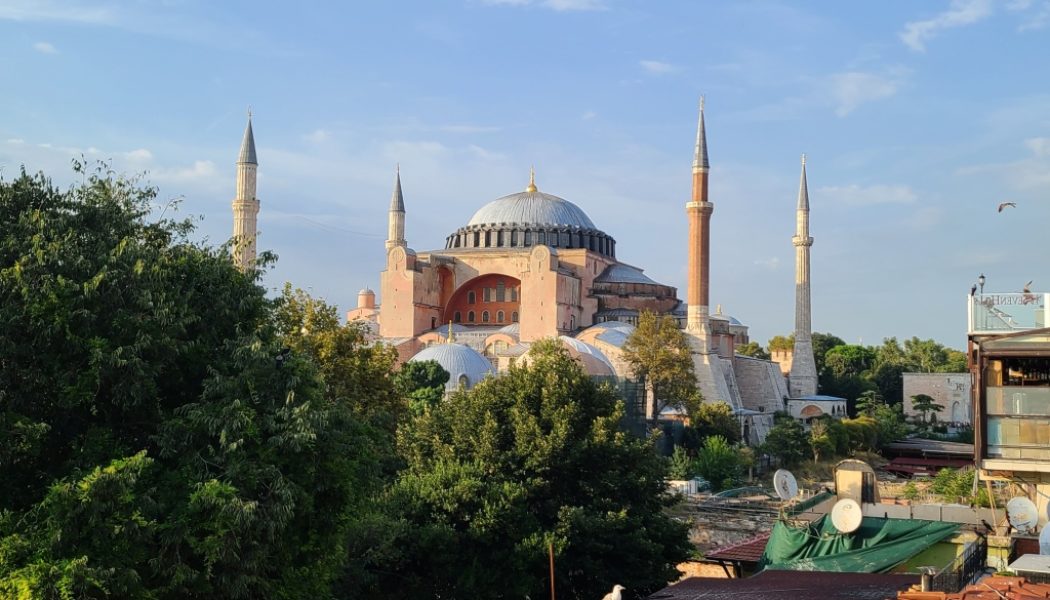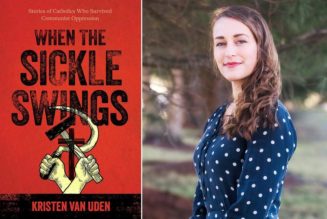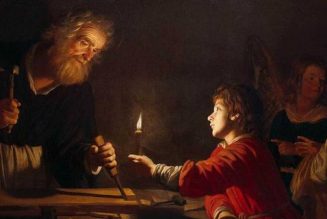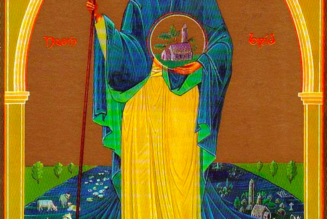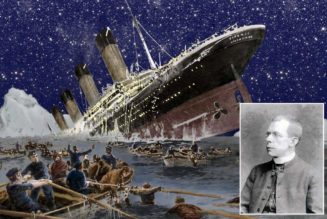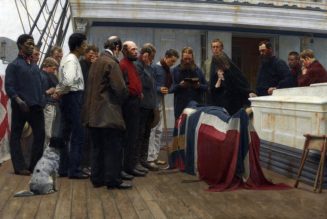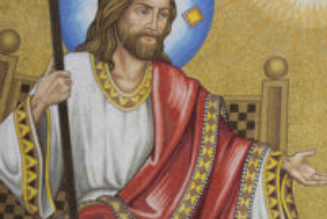
Note from the Author: Copy/paste GPS Coordinates listed below into Google Maps to see or travel to each location.
I had the opportunity to travel with a friend of mine to the incredible country of Turkey recently. My wife, my oldest son, and I lived in Turkey for 2 years and it had been over 10 years since I had set foot in my home away from home in the Middle East.
My wife very generously watched our four kiddos to allow me to go on my pilgrimage.

After landing at Istanbul’s stunning airport…

…we first drove to the Church of St. George at the Phanar (above, GPS Coordinates: 41° 1’45.17″N, 28°57’6.19″E). This church is the Greek Orthodox Church’s version of the Roman Catholic Church’s Vatican.
Inside this small church are the remains of three Saints of great importance to both the Eastern and Western Churches and Saints who I have a special devotion to.

The first of these Saints is St. Basil the Great:

The other two Saints are St. Gregory of Nazianzus and St. John Chrysostom:

These three men–all Doctors of the Church–had indelible impact on the Church and bravely defended the Faith from heresies despite threats and persecution from not only pagans but fellow Christians! St. Basil studied in Constantinople/Istanbul in the mid-300s, and St. Gregory and St. John Chrysostom were both appointed archbishops of this massive city in A.D. 380/1 and A.D. 397, respectively. Pope St. John Paul II gave these portions of St. Gregory’s and St. John’s remains to the Greek Orthodox Church as a sign of friendship, solidarity, and fidelity. Rome also donated the relics of St. Basil interred there.
After visiting these heroes of our Faith and asking them to pray to God for our intentions, we caught a glimpse of the beautiful Golden Horn waterway which borders to the north the peninsula on which old Istanbul stands. We also visited the Bulgarian Orthodox Church of St. Stephen (GPS Coordinates: 41° 1’54.14″N, 28°56’58.42″E) which was made of prefabricated steel pieces in Austria and assembled into a church when the pieces arrived in Turkey! Beautiful!


We then got some dinner at a terrace restaurant overlooking the Bosphorus Strait and the amazing Hagia Sophia. Here I am with some Çay (tea) and the Hagia Sophia in the background:

A beautiful Turkish dinner:

After dinner, we visited the Hagia Sophia (GPS Coordinates: 41° 0’31.38″N, 28°58’46.11″E). The current structure is the third church on this site and dates to the A.D. 500s. It served as Constantinople/Istanbul’s Cathedral until 1453 when the Turks conquered the city from the Byzantines. Sultan Mehmet II rode into the church on his horse to the altar and proclaimed the Hagia Sophia a mosque. Nearly 500 years later, the Hagia Sophia was declared a museum–serving as neither church nor mosque–by Turkey’s first president, Ataturk, in 1935. In 2020, Turkey’s current president, Recep Erdogan, declared the Hagia Sophia a mosque yet again. As a result, the Turkish government covered the marble floors of the Hagia Sophia in carpeting for Islamic prayer. Like a war trophy, the Hagia Sophia still displays the names of Islamic conquerors written on massive discs hung from the heights of the building’s interior, but yet still contains strikingly majestic Christian mosaics.


A beautiful Byzantine mosaic of Jesus and Mary at the front of the Hagia Sophia (once overlooking its altar which has been removed) is now covered by large sheets. Despite this, one can still see them both looking down with love on all the people below.

While I was inside the Hagia Sophia, I listened to the album below (on headphones) to better experience what the Hagia Sophia would have been like before the conquest of 1453. This album is by a group that sings Byzantine (Greek) liturgical chant from pre-conquest times and had their vocal recordings synthesized through a sound filter created using scientific measurements of the acoustics in the Hagia Sophia (before all the Islamic carpet was installed). The shocking result is a very close approximation of what the Hagia Sophia would have sounded like inside during a Christian Divine Liturgy over 500 years ago!

According to St. Nestor the Chronicler, Russian envoys who visited Constantinople/Istanbul in A.D. 987 (when the Western and Eastern Churches were still in Communion) reported to their prince about the worship in Hagia Sophia: “Then we went to Greece, and the Greeks led us to the edifices where they worship their God, and we knew not whether we were in heaven or on earth. For on earth there is no such splendor or such beauty, and we are at a loss how to describe it. We only know that God dwells there among men, and their service is fairer than the ceremonies of other nations. For we cannot forget that beauty. Every man, after tasting something sweet, is afterward unwilling to accept that which is bitter, and therefore we cannot dwell longer here.” The music from this album helped me taste–to a very small degree–what this experience must have been like when the Hagia Sophia was still used for Christian worship.
The next day, we drove about 4 hours southwest to the Troad–the region of the city of Ancient Troy (from Homer’s Iliad and Odyssey). Our first stop there was the Ancient city of Troas (GPS Coordinates: 39°45’6.68″N, 26° 9’32.80″E)–a stopping point of St. Paul, St. Luke, and their companions as mentioned in the book of Acts, Chapter 20.

Below is a Roman Road in Troas leading through the city’s center (GPS Coordinates: 39°45’7.38″N, 26° 9’29.42″E). It is very likely St. Paul and his companions would have walked on these very stones:

Not far from the city center is the silted-up former port of Troas (GPS Coordinates: 39°45’30.06″N, 26° 8’24.75″E) you can still see some ancient columns poking out of the coastline near the port’s now land-covered entrance.)

Further inland from the silted-in port entrance is what’s left of the port itself…now a large pond (below, GPS Coordinates: 39°45’27.67″N, 26° 8’31.34″E). In the First Century A.D., this port would have been filled with sailing boats carrying passengers and trade goods. St. Paul, St. Luke, and their companions would have sailed back and forth through this very port on their missionary journeys.

After visiting Troas, we drove to the famed Tumulus of Achilles–the tomb of the famous warrior from the Trojan War (GPS Coordinates: 39°55’1.68″N, 26° 9’32.34″E). A tumulus is a small, often manmade hill usually built over a grave. Tradition and geography point to this being the most likely location of the tomb, visited by famous military commanders like Xerxes of Persia and Alexander the Great.






From here, we traveled across the Troad up to the likely site of the Greek Camp during the 10-year long Trojan War. According to a superb geomorphic study by John Kraft, George Rapp, Ilhan Kayan, and John Luce published in the February 2003 edition of the journal Geology, the area around Troy once had a bay and looked like the image below from their study.

Below is a view of the Aegean coastline looking north, with me standing within the red circled area marked on the map above. The landing place of the Greeks and their camp during the Trojan War (in around 1250 B.C.) was in this area (GPS Coordinates: 39°58’6.99″N, 26°10’28.26″E).


We then drove into the Trojan Plain where actual battles of the Trojan War would have occurred. One of the battles was along the Xanthos River (also named the “Scamander River”) which still flows today. According to the Iliad (21, 1-11), “But when they came to the ford of the fair-flowing river Xanthos…Achilles broke the Trojan line and sent half of the enemy flying in rout across the plain towards Troy…But the remainder were pinned back against the deep stream with its silver eddies. In they tumbled with loud splashes, and the din resounded from the depths of the pools and from the banks on the other side. With piteous cries they swam here and there, whirled round by the current.” Below is a photo on the Plain of Troy looking towards the Xanthos (where the far ridge of trees is) with Ancient Troy on the other side; this location may have been near the location of the battle in the citation above from the Iliad (GPS Coordinates: 39°56’13.79″N, 26°13’21.55″E). The next photo is the present day river Xanthos (taken at GPS Coordinates: 39°56’45.86″N, 26°12’48.63″E)–this is where the Trojan soldiers would have fallen after Achilles and the Greeks’ attack.


Last but certainly not least, we drove up from the Plain of Troy to the remains of the ancient city itself (parked at GPS Coordinates: 39°57’23.14″N, 26°14’29.41″E). The site of the ancient city was lost for centuries until it was rediscovered by a German man named Heinrich Schliemann in the 1800s. During his excavations, Schliemann discovered *nine* different stages of the city dating from 2920 B.C. to 2450 B.C. (Troy I) to A.D. 550 (Troy IX). The stage of Troy when the Trojan War happened was likely sometime during Troy VI or Troy VII (around 1250 B.C.). Below is a picture of me with a replica of the Trojan horse at Ancient Troy.

Below is a picture from atop some of the ruins of the walls of Troy VI looking towards the Plain of Troy. The battles of the Trojan War took place in this plain–the Greeks attacked across this plain up to the city. The far line of trees near the horizon is where the Xanthos River is.

The impressive walls of Troy VI in the photos below, standing since the time of the Trojan War.



After visiting Troy, we drove back to Istanbul to enjoy the beautiful evening there and saw a whirling Dervish and other exquisite sights.




The next day, we drove 2 hours from Istanbul to the town of Iznik (Ancient Nicaea). Nicaea was the location of the famous Ecumenical Church Councils of Nicaea: Nicaea I in A.D. 325 and Nicaea II in A.D. 787.
If you read the stories about these Ecumenical Councils, the drama surrounding each is substantial.
The First Council of Nicaea refuted the Arian heresy and developed the first version of the Nicene Creed, the summary and profession of faith Catholics and Orthodox Christians recite in our liturgies each Sunday. Prior to A.D. 313, professing the faith in this creed would been grounds for imprisonment or worse. It was in A.D. 313, twelve years prior to Nicaea I, Emperor Constantine legalized Christianity in the Roman Empire with the Edict of Milan and lifted the scourge of persecution from the early Church. Although the torture and slaughter of Christians at the hands of the Roman Empire ceased, suffering from heresy within the church began to set in; satan thus pivoted focus in earnest to a different strategy for destroying the Church–divisions from within. A priest within the diocese of Alexandria, Egypt named Arius began teaching Christians that Jesus was not equal to God the Father and therefore, not really God. Many in the Church began to believe this teaching, despite it being contrary to Scripture and the Deposit of the Faith handed down by the Apostles. With this heresy dividing the Church, Constantine decided it best to bring bishops from across the church, east and west, to the city of Nicaea (a central location in his empire) to sort out this divisive issue.
And so bishops from across the Church assembled in Nicaea. Miraculously, with Christianity now legalized throughout the Empire, the bishops no longer had to operate in secret and Constantine even covered the costs of their travel to Nicaea for the council! This was a stark change from previous emperors some of whom were merciless persecutors of the Church. One can only imagine at the opening of the council in May of A.D. 325 the sight of hundreds of bishops (one of which was St. Nicholas of Myra–Santa Claus!) walking through the busy streets of ancient Nicaea, many of whom still bearing the physical scars and injuries from tortures sustained during former persecutions of the faith. According to Bishop Eusebius of Caesarea in his great work The Life of Constantine, Book III, Ch. 7, “a single house of prayer, as though divinely enlarged, sufficed to contain at once Syrians and Cilicians, Phœnicians and Arabians, delegates from Palestine, and others from Egypt; Thebans and Libyans, with those who came from the region of Mesopotamia.” (See https://www.newadvent.org/fathers/25023.htm for Eusebius’s full account of the First Council of Nicaea). It is thought the ruins of this “house of prayer,” at which at least one meeting of the council took place, may have been discovered in 2015 outside the city walls of Nicaea and under the water of the lake on its western boundary (GPS Coordinates: 40°25’32.85″N, 29°42’35.29″E). We had the opportunity to see the ruins of this church! I had packed my swimsuit and had hoped to explore the underwater ruins myself, but the area was marked off and had scuba-diving archaeologists there doing a site visit. It was encouraging though that the remains of the church were being examined and preserved with such care and respect.




Nearby to the remains of this church (which some scholars believe is dedicated to and built over the tomb of St. Neophytos, a 16-year-old Christian martyr in Nicaea), are the alleged ruins of the “Senatus Palace” of Constantine (some of which may be underwater as well, GPS Coordinates: 40°25’38.81″N, 29°42’42.04″E). According to Eusebius’s Life of Constantine, it was in this grand building the emperor himself met the bishops to close out the council in August of A.D. 325, three months after its opening. Through God’s grace, it was the emperor Constantine and the “Nicene Fathers” (as the non-Arian bishops at the council were called), who helped ensure the Catholic and Apostolic Faith was defined for humanity for all time. I took the opportunity, standing on this hallowed ground, to pray the Nicene Creed given to our Church through the Holy Spirit at this very place.


The Second Council of Nicaea refuted the Iconoclastic heresy. This heresy held that there should be no Christian religious images because venerating these images would be akin to idolatry. This heresy was unfortunately embraced by the Byzantine Emperor Leo III who issued pronouncements between A.D. 726 and 730 against the veneration of images. Leo decreed that any holy images in churches were idols and should be destroyed. These proclamations caused terrible rifts in the church with many passionately supporting the destruction of religious images (i.e. being supportive of iconoclasm) and many standing against it. According to the Catholic Encyclopedia, due to opposing Iconoclasm, monasteries were destroyed, monks put to death, tortured, or banished.
This heresy lingered for decades, however, attempts started to be made to hold a church council to definitively address the issue of iconoclasm. Although some clergy attempted to hold a council in Constantinople on the matter, it was broken up by pro-iconoclast soldiers. In an effort to put some distance between the capital and the new council, Nicaea was once again chosen as the site for another council. The Second Council of Nicaea opened on 24 September 787 and closed on 23 October 787. The council declared that icons deserve reverence and veneration but not adoration, which is reserved for God.
The church where the Second Council of Nicaea was held still exists today (see photos below, GPS Coordinates: 40°25’45.07″N, 29°43’12.48″E). Ironically, it is also named “Hagia Sophia Church” and it was also converted into a mosque (in 2011).




The Hagia Sophia Church in Nicaea is physically small, but the impact of the council held within its walls cannot be overstated. Because of the Second Council of Nicaea held here, we are able to have crucifixes in our houses and around our necks. Because of this council, millions of works of art throughout history with images of Christ exist. As I stood reflecting in this church, I reflected that if it wasn’t for God’s grace and the brave Christians who called this council, humanity would not have holy images like Leonardo’s painting of the Last Supper, the Divine Mercy Image, or the statue of Christ the Redeemer. The prayers prayed, words spoken, and work done within this church made a lasting impact on the entire world for all time. Amazing.
After visiting Nicaea, we drove back to Istanbul. I was excited to visit the Istanbul Archaeological Museum, but on my way there I took a quick detour to Sultanahmet Park Square where the ancient hippodrome (chariot racing stadium) of Constantinople once stood. In an effort to make his new city on par with Rome, Constantine brought artifacts from across his empire to decorate his capital. Two of the monuments he brought to decorate his hippodrome are still standing! One of these is the famous Serpentine Column (GPS Coordinates: 41° 0’20.31″N, 28°58’30.36″E). This column was forged by the Greeks after they defeated the Persians at the Battle of Plataea in 479 B.C. (the opening of which is shown at the very end of the movie “300” from 2006) are s The Greeks melted down the captured armament of the Persians and forged a column of three intertwined snakes with the names of the Greek city states who had united against the Persians and defeated them inscribed on the snakes’ coils; the intertwined snakes symbolized the lethality of the Greek city states when united against a shared enemy. The column was set up outside the famous Temple of Apollo in Delphi as a thank offering to the god, but was later moved by Constantine to decorate the hippodrome (chariot racing course) of his new capital city–Constantinople. Unfortunately, a drunk person broke the heads off the snakes several hundred years ago and only one has been found.



While I was at the hippodrome, I also found the site where on 12 January 2016 an ISIS suicide bomber killed 13 and injured up to 14 people in a tour group. Below are some pictures of the attack and its immediate aftermath and what the place looks like today. You can still see damage to the paving, pockmarked from shrapnel, at the spot where the bomber stood when he detonated his suicide vest (see photos below). It was a chilling experience to stand by such a terrible spot.
Jan. 12, 2016 – Several people have been killed in an explosion at Sultanahmet Square near the historical Roman obelisk, district of Istanbul popular with tourists. This is a screen shot of the explotion from a toruist camera. (Credit Image: © Depo Photos via ZUMA Wire)
” data-medium-file=”https://zistezesto.files.wordpress.com/2022/10/instanbul-explosion-fatal-turkey-tourists-02.jpg?w=300″ data-large-file=”https://zistezesto.files.wordpress.com/2022/10/instanbul-explosion-fatal-turkey-tourists-02.jpg?w=871″ src=”https://zistezesto.files.wordpress.com/2022/10/instanbul-explosion-fatal-turkey-tourists-02.jpg?w=871″ alt class=”wp-image-334″ srcset=”https://zistezesto.files.wordpress.com/2022/10/instanbul-explosion-fatal-turkey-tourists-02.jpg 871w, https://zistezesto.files.wordpress.com/2022/10/instanbul-explosion-fatal-turkey-tourists-02.jpg?w=150 150w, https://zistezesto.files.wordpress.com/2022/10/instanbul-explosion-fatal-turkey-tourists-02.jpg?w=300 300w, https://zistezesto.files.wordpress.com/2022/10/instanbul-explosion-fatal-turkey-tourists-02.jpg?w=768 768w” sizes=”(max-width: 871px) 100vw, 871px”>





After visiting the hippodrome, I walked to Istanbul’s archaeological museum (GPS Coordinates to entrance/ticket office: 41° 0’39.87″N, 28°58’49.51″E) which has an INCREDIBLE collection of artifacts from ancient western civilization. It was one of the top 5 museums I’ve ever visited.








In Istanbul’s Archaeological Museum, they also have the one remaining head Me of the famous Serpentine Column from Istanbul’s hippodrome.


After visiting the museum and getting some dinner, I made the decision to back to the Hagia Sophia one more time. Each time I set foot in that building, both the grandeur of the structure itself and reflecting on the history that happened here never fail to move me. This time, I had the opportunity to take my time inside to contemplate more about the sanctity and tragedy witnessed by this building over the last 1,500 years. It is the site of countless liturgies and yet also the site of numerous atrocities due to conquests. One of the experts on the church and Byzantium named Bob Atchison I read before my trip described the Hagia Sophia as even more marvelous in its earlier days. He commented: “We can still imagine what a service was like in Hagia Sophia. Liturgy in the church was sung – there is a ten second reverberation in the church that makes it hard to understand the spoken voice. Singing services were invented for the church. The choir of Hagia Sophia in the 7th century had 160 singers. Hymns and chants were composed for the church and followed the hourly services that were held in the church. Hagia Sophia was a processional church; bishops, clergy, and choristers lead the people into the church carrying crosses and icons with clouds of perfumed incense, spread by swinging and gently clanging silver censors. This was combined with the light reflected from the golden vaults and the beautiful mosaics and other artwork in the church that also reflected light. The Holy Altar was covered in glinting silver and gold and set with rich jewels and pearls. Finally the splendid rich marble revetments and columns all added to this unique experience of worship and wonder.” I reflected on this as I looked at the glinting remains of some ceiling mosaics from Byzantine times still clinging to the ceiling in one of the Hagia Sophia’s side aisles (see below).

I finally came to the front right corner of the Hagia Sophia and saw the entrance to the Chapel of the Holy Well (see photo below and Atchison’s article at https://www.pallasweb.com/deesis/chapel-holy-well-chapel-passage-of-st-nicholas.html for more information). This chapel, which unfortunately is not currently open to the public, once held the stone well-head from Jacob’s Well in Samaria–Jesus had sat on this well-head when he spoke to the Samaritan Woman (in John, Chapter 4). During the Byzantine Emperor Justinian’s reign in the A.D. 500s, The people of Samaria revolted against Byzantine rule and Justinian gave orders that the well-head should be removed and brought to Constantinople to prevent it from being destroyed by the rebels. The Chapel of the Well was a major attraction for pilgrims to the Hagia Sophia. I could imagine the long line of pilgrims from hundreds of years in the past filing into the Chapel for a chance to touch and venerate such a holy relic–a relic which had served for a few minutes in the First Century as the throne of the Lord of the Universe. Near this area of the Hagia Sophia was also one of the entrances into the church for the Byzantine royal family. It was intriguing to imagine the emperors and empresses of Eastern Rome walking along the space in front of me to participate in the Hagia Sophia’s Divine Liturgy.

With the Hagia Sophia no longer used for Christian worship, the building in its current state served as a reminder to me that Christ’s Kingdom is not of this earth as the Gospel says. The building of the Hagia Sophia was made sacred by its consecration as a church and by 1,000 years of worship through the divine Sacrifice of the Mass/Divine Liturgy. However, this world is passing, and I feel it is important not to overly cling to the objects of this life–no matter how difficult–but to focus firstly on clinging to our Lord through the Sacraments, His Word, the Church, and living out Christ’s example through our actions. I was able to ponder all of these things in prayer and to beg God for reparation for the atrocities committed by men at the hands of conquering Christians and Muslims inside this great building. Before I knew it, it was 2300hrs and the Hagia Sophia was closing for the night! As I walked out of the great building, I saw yet another reminder of its former greatness as a church: crosses undone on its doors by the cross beams being removed. Lord, have mercy.


After visiting the former cathedral of Constantinople/Istanbul, the next morning my friend and I drove to the *current* cathedral: The Basilica Cathedral of the Holy Spirit (GPS Coordinates: 41° 2’40.80″N, 28°59’9.44″E). The entrance to the premises of this church is very nondescript for security reasons and it took us a little while to find it!
Once you go through the street entrance and enter the front courtyard of the cathedral, you feel right at home!


That morning, we attended a Chaldean Catholic Mass as opposed to the standard Roman Catholic Mass we usually attend each Sunday. The Chaldean Catholic Church is one of several Eastern Catholic churches in full communion with Rome. It is made up mostly of Iraqis and traces its founding to St. Thomas the Apostle, St. Jude the Apostle, and St. Bartholomew the Apostle who ministered in the East after the Descent of the Holy Spirit at Pentecost. The Mass we attended was very beautiful and was spoken entirely in a Syriac language. The only word I could recognize was “Amen” (pronounced “Ameen” by the congregation), but I could follow what was happening in the Chaldean liturgy as it closely mirrors that of the Roman liturgy. Other than receiving Jesus and the mesmerizing chant during the Mass, the other most beautiful aspect of this experience was seeing so many people attending! Young and old Chaldean Catholics were present and worshiping our Lord in full communion with Catholics all around the world!

After Mass, we walked around the cathedral, took pictures, and took in its beauty. While I was walking, I specifically noticed a very cool painting of Pope St. John XXIII who was the Vatican’s representative to the country of Turkey before he became pope. I also saw an image commemorating St. Andrew the Apostle (“Andrea”) towards the front of the church. It was St. Andrew who is traditionally is said to have founded the church of Byzantium (later to become Constantinople, and then Istanbul). The Orthodox Church also traces its Apostolic founding back to St. Andrew.


After we walked around the cathedral, we stepped outside and witnessed yet another incredible sight. Young men (mostly) and some young women of the Chaldean congregation were circled around their young, vibrant priest–now out of his vestments–socializing with him, and spending time with him. It was a beautiful sight and gave me hope for the future of the Catholic Church.
After going to Mass, we picked up some souvenirs for our wives and drove to the airport. It had been an incredible pilgrimage, filled with God’s blessings. All thanks to Him for a safe and holy adventure! Thanks also to His mother, St. Raphael the Archangel, St. Frances of Rome, and St. Christopher for their prayers for our safe travels.
If you enjoyed, this post, check out my one-of-a-kind book, The Second Person of the Trinity in Time and Space: What is Known Historically About Jesus and the Holy Sites of the New Testament, sold on Amazon.com! (see below)
.wordads-ad-wrapper { display:none; font: normal 11px Arial, sans-serif; letter-spacing: 1px; text-decoration: none; width: 100%; margin: 25px auto; padding: 0; } .wordads-ad-title { margin-bottom: 5px; } .wordads-ad-controls { margin-top: 5px; text-align: right; } .wordads-ad-controls span { cursor: pointer; } .wordads-ad { width: fit-content; margin: 0 auto; }
Join Our Telegram Group : Salvation & Prosperity
